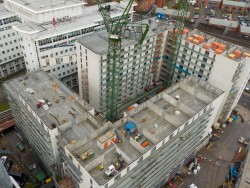The Chapel Wharf Project in Salford represents a major development in the delivery of multi-storey residential construction and has utilised PCE Limited’s hybrid offsite concrete ‘system build’ approach.
The Chapel Wharf Project is delivering 995 private rental sector (PRS) apartments across four blocks ranging in height from 13 to 23 storeys. The scheme is being delivered by Sir Robert McAlpine in just two and a half years with the precast superstructures being completed in less than two years.
The development is situated on a former car park next to the Lowry Hotel, in a prime city centre location with easy access to transport links and Manchester’s bustling retail and commercial districts. Due to the city centre location which is sandwiched between an existing residential development, the Lowry hotel and the Manchester tax office, and the fact that the four blocks occupy the majority of the site footprint, the site logistics strategy is a major challenge which has been the key to developing a successful ‘fast track’ construction strategy.
The four large luffing jib tower cranes each services a block with three of the cranes sharing an offloading area within the site whilst one of the cranes utilises an offloading area created by a lane closure on the adjoining Chapel Street. Careful sequencing and planning allows up to 24 deliveries of precast components and bathroom pods to enter this busy site every day whilst still allowing delivery of other construction materials by the main contractor. This logistics strategy is managed and controlled by PCE’s site construction team and requires every vehicle movement and every crane lift to be pre-planned to the minute.
Key to the delivery model for the scheme as a whole is the adoption of an ’offsite mindset’ from the developer Dandara and the contractor Sir Robert McAlpine. Most of the superstructure is being delivered by PCE using structural precast concrete components which are manufactured offsite by PCE’s manufacturing partners in several factories across the UK and Ireland.
These components are delivered to site on a just-in-time basis and are then assembled into position by PCE’s directly employed construction operatives. This design for manufacture and assembly (DfMA) strategy means that the four blocks can be assembled onsite simultaneously by a team of just 45 construction operatives. The process involves structural wall and slab components which are manufactured to very tight tolerances and with high quality, consistent finishes, being lifted into position, temporarily restrained and then stitched together using a series of pre-engineered structural connections which satisfy both robustness and stability requirements of the structure.
The ‘system build’ approach delivers much greater levels of predictability and certainty whilst significantly reducing the number of deliveries to site along with huge reductions in onsite man hours compared with traditional construction methods. It’s not just the superstructure that benefits from significant enhancements in efficiency. A series of ‘smart’ strategies have been adopted as part of the structural solution that generate massive benefits to the overall delivery programme along with the removal of numerous follow-on trades.
Façade Construction – an integrated facade solution is a key component of the superstructure delivery strategy with the external envelope being delivered as a composite sandwich construction of decorative reconstructed stone, hung from an inner structural concrete wall, with an inner core of dense insulation. This façade construction results in a durable, high-quality and high-performing envelope being constructed concurrently with the structural frame. Windows are being pre-installed within the sandwich panels at the precast factory resulting in a weathertight, scaffold-less envelope construction. Panels are configured to apartment layouts so range from 7m to 10m long by 2.85m tall. This means that up to 230m2 of façade per construction team can be constructed each day.
To continue reading this article please visit: Offsite Magazine









